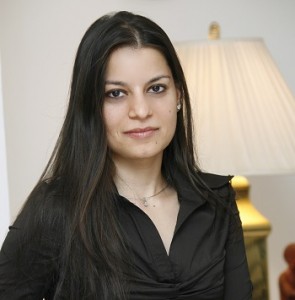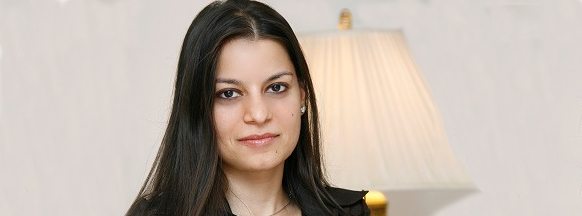Wharton alum designed stone finishes of Delhi, Mumbai airports, including cladding, flooring exterior and interior and design consulting for finishes.
By Global India Newswire
PHILADELPHIA: Kanika Dewan is the founder of Ka Design Atelier and president of the Bahrain-based Bramco Group of Companies.

The Kolkata-born entrepreneur was responsible for all the stone works of the two largest airport projects in India: the Terminal 3 at Delhi’s Indira Gandhi International Airport, which was completed in 2010, and the new Chhatrapati Shivaji International Airport. Her other major works include the Leela Palace Hotels in Chennai and Delhi; the Philippe Stark building in SoHo, New York, and the Bridgewater Hindu Temple in New Jersey.
Dewan, 36, was in Philadelphia last month to attend the Wharton India Economic Forum. She spoke to Global India Newswire on the sidelines.
Here are edited excerpts:
Your family has been in the mining business in the Middle East for decades. You founded Ka Design Atelier as a separate entity. What was the inspiration behind it?
Ka Design Atelier is integrated with my family business, Bramco, which was started about 38 years ago by my father, which is one of the leading mining and natural resources groups. I saw growing up these natural resources—we own our own mines—being used. When I went to Wharton I had a business plan to bring them to the end user. I didn’t really have an interest in lower down in the supply chain, but I wanted more of a creative outlet, even though I did finance at Wharton. [Dewan graduated from Wharton Business School and the University of Pennsylvania with a dual degree in Finance and Entrepreneurial Management in Economics.]
I said why don’t I leverage what is there and bring it to another business model which is a vertically integrated solution, where you go from the mines to the end user and provide a unique aesthetic statement. That is how Ka Design Atelier was born. We developed this model literally with a friend of mine who graduated along with me from Wharton and created a business plan. I was left to my own to implement it. We started out of Metuchen, New Jersey, with a residential site. The big launch was the job of a designer, a celebrity client. He actually is the one who motivated and said, “I really like your creative thinking even though you don’t have a design background.” I had the physics background and so I guess I could somehow intuitively integrate the science and the artistic side of it. So he gave me his home which is on 50 acres of land to do and that was kind of the turning point after which I gained the confidence and the realization that I really have this artistic side to me. Then I participated in a big international design show at the Jacob Javitz Center in New York and got an award there and then went forward. That is how it’s been going.
Does Ka Design work with Bramco?
Ka Design Atelier, which is responsible for quality control, works jointly with Bramco in projects, where, obviously, I wear multiple hats, being the owner of both. My teams are hired separately and are individually. The client gets an audit in a way of the quality control and the creative direction is not marred in any way by the fact that the company in which I have an interest is supplying the product.
Why did you decide to go to India?
We began with specializing in very high-end residential sector, and doing turnkey projects. When I went to India, I wanted to expand there and make a statement. That was really more of a patriotic move. It was something that I felt always growing up even though I never lived in India. People always consider India as a third world country, yet India has so much history. People have been in search of India for ages. It has always been an inspiration to everyone, but they forget it because it has such an ancient history.
Was the Delhi airport your first project in India?
In India, it was my first major landmark project. Prior to that, we had done some projects such as the Westin hotel in Gurgaon. But for me they were all what I call daily projects. The airport project was the first one where we truly integrated the Ka Design concept with the Bramco design to build the turnkey model, where one person is responsible for everything. It was a model which was developing for many years, but now everyone has jumped on to the bandwagon.
After the Delhi airport, you went to do the Bombay airport as well. What was your experience working in India? You have spent whole your life outside of India. Was it difficult to adjust?
We divided it into social aspect and work aspect. Social aspect, yes it is definitely difficult to adjust in India in the sense that you are very independent in the US. For example, you drive around yourself, but it is not so in India. In India, you go from independent to being sheltered. You almost live two contradictory lives. At work, you are completely in control. People see you as a very strong person, going on sites and running around everywhere independently, may be a thousand people of your labor force surrounding you, apart from architects and managers. But then you go home and you are leading a very sheltered life, where you have got a driver, and even when you walk your dog, you need three security guards. In the night, I don’t think of going out because you are always on the watch. It is a very different environment culturally. Socially and culturally, I think, America is very rich, and it is about self-development. I think, in India, you just kind of go through the motions of life.
Work-wise, however, I feel it was very similar to America in the sense that it is and aggressive, fast-paced environment—maybe it is because of the industry I am in. I didn’t find much difference in the industry, like people saying “how it is to work in this male-dominated industry?” In America, I have found equally male chauvinistic people. Work-wise, I think it is a challenge in India, but it is enjoyable at the same time.
You have said elsewhere that you have refused to pay bribes in India…
There is this point in Bombay, octroi point, where you pay octroi taxes when your trucks and containers go through. Every time our trucks go through there, the guys out there would find some missing information and would say, “I am going to put a challan of 100,000 rupees” Then he would demand a 5,000 rupees unofficial challan to clear the trucks. But I have instituted a strong anti-bribery policy. In India, they think of bribe as a quantum vs. a principle. So they think, if it is a 200 rupees bribe, why not give it because by giving 200 rupees I can get my trucks passed rather than impounded for 50,000 rupees, thus delaying the project. I am sure my finance people are willing to pay. And when I say “No”, they are surprised because financially it does not make any sense.
Do you think the Indian diaspora and the diaspora-driven businesses are more welcomed in India now?
Yes, they are being welcomed. In recent years, you have gone from being a “not required Indians” to being a “necessary returned import.” Your import is seen as value-added. Yes, they are more welcomed and I think that they are treated with a high regard. I do think the Indian diaspora Is being welcomed but there is a resistance when you don’t comply to doing business in the “Indian way.”
You are in the Guinness World Records for making the largest marble mosaic in the world. Could you tell us more about that project?
Yes, that is in Oman, and it is a large portrait of Sultan Qaboos bin Said al Said, the ruler of Oman. How that came about is we do design and build for luxury yacht with a propriety technology, Honeycomb technology, for lightweight stones. We make and manufacture lightweight medallions for ships. This technology was developed for the US market while I was here. And I developed it for homes because most homes here are wooden and not concrete. That is how we moved to the luxury yacht sector and the first luxury yacht we did was for Sultan Qaboos. Then we did one for Russian businessman Roman Abramovich. As a result, we have been doing a lot of work in Bahrain and in the Middle East, and Bramco has also been doing similar work. That is how Sultan Qaboos Consortium people found us and they asked us to create a portrait of the king on his 40th accession day. That is how the portrait came about.
Then, Guinness World Records officials came and looked at it. There were certain criteria that we had to go through. You could not use mosaic, you had to use real marble and granite, you couldn’t use any imitations or synthetic, which is perfect because it is our philosophy to use everything that is natural.
What is your next big project?
Apart from our regular construction and design works, such as airports and hotels, we continue to do yachts. We are doing another luxury yacht, which could be the largest in the world. I want to now delve into sustainable design, which is my passion. I want to design sustainable design housing for the masses. Application will be mainly in India. The inspiration came from what I saw while doing the airport project: other companies were not providing any shelter to their laborers. Sometimes they were living inside tents in severe cold. In summers, they’re sleeping on the floor and literally without proper bathroom facilities.
You have projects in India, the US and the Middle East. How do you divide your time?
I literally live in a plane. It is nice to get the best of all worlds and I think different projects get me stimulated. When I am in America, I get more involved in the research- and knowledge-based projects because what America brings is incredible education and university research, which can add to innovation. And what India does is it allows you to implement the innovation because as it is the land of jugaad anything can be done. So it is very interesting to marry the two. (Global India Newswire)
To contact the author, email to editor@americanbazaaronline.com



